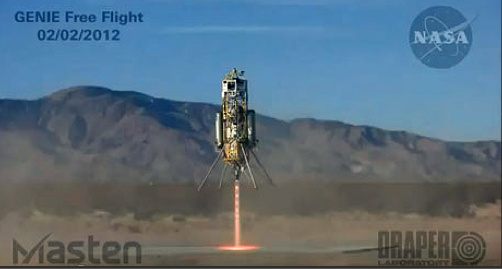Private Xombie Rocket Aces NASA Landing Test

A private suborbital rocket passed a landing test for NASA with flying colors this month in a succesful trial run of technology that could help future spacecraft touch down on other planets or moons.
On Feb. 2, Masten Space Systems' Xombie rocket rose 164 feet (50 meters) off a launch pad in the California desert, moved sideways the same distance, and then landed softly on another pad. The entire flight lasted just 67 seconds.
The brief test flight demonstrated a new control system called the Guidance Embedded Navigator Integration Environment (GENIE), which was developed by the nonprofit Draper Laboratory in Cambridge, Mass. NASA's Flight Opportunities Program sponsored the recent flight, in the hopes that GENIE will enable more ambitious landing demonstrations in the future.
"The Draper and Masten team has done a tremendous job pulling together this flight demonstration in a short amount of time," said John Kelly, Flight Opportunities Program manager at NASA's Dryden Flight Research Center in Edwards, Calif. "Draper was awarded this task in September 2011. This capability will allow the program to quickly demonstrate landing technologies for future space missions."
After being tapped by the Flight Opportunities Program for the landing task, Draper chose Masten to provide the flight vehicle. Xombie has a record of success; in October 2009, the vehicle won the $150,000 second prize in NASA's Lunar Lander Challenge, which sought to spur the development of private spaceships and their flight software.
Masten is developing a variety of reusable, unmanned vertical-takeoff and –landing vehicles for suborbital spaceflight. The company also hopes to build robotic spaceships for orbital missions eventually.
Last year, the Flight Opportunities Program awarded Masten a two-year contract to fly research and technology payloads to suborbital space. Six other private spaceflight companies — including Virgin Galactic, Armadillo Aerospace and XCOR Aerospace — also received funding. Altogether, the contracts are worth a total of $10 million.
Breaking space news, the latest updates on rocket launches, skywatching events and more!
NASA hopes the Flight Opportunities Program helps enable regular, reliable and low-cost access to near-space, with easy recovery of intact payloads.
Follow SPACE.com for the latest in space science and exploration news on Twitter @Spacedotcom and on Facebook.

Space.com is the premier source of space exploration, innovation and astronomy news, chronicling (and celebrating) humanity's ongoing expansion across the final frontier. Originally founded in 1999, Space.com is, and always has been, the passion of writers and editors who are space fans and also trained journalists. Our current news team consists of Editor-in-Chief Tariq Malik; Editor Hanneke Weitering, Senior Space Writer Mike Wall; Senior Writer Meghan Bartels; Senior Writer Chelsea Gohd, Senior Writer Tereza Pultarova and Staff Writer Alexander Cox, focusing on e-commerce. Senior Producer Steve Spaleta oversees our space videos, with Diana Whitcroft as our Social Media Editor.
